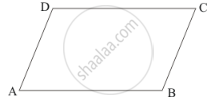Advertisements
Advertisements
प्रश्न
Complete the following statement by means of one of those given in brackets against each:
If opposite angles of a quadrilateral are equal, then it is necessarily a ....................
पर्याय
parallelogram
rhombus
rectangle
उत्तर
If opposite angles of a quadrilateral are equal, then it is necessarily a parallelogram.
Reason:

ABCD is a quadrilateral in which ∠A =∠C and ∠B = ∠D.
We need to show that ABCD is a parallelogram.
In quadrilateral ABCD, we have
∠A = ∠C
∠B = ∠D
Therefore,
∠A + ∠B = ∠C + ∠D …… (i)
Since sum of angles of a quadrilateral is 360°
∠A + ∠B = ∠C + ∠D = 360°
From equation (i), we get:
(∠A + ∠B) + ( ∠A + ∠B) = 360°
2(∠A +∠B ) = 360°
∠A + ∠B = 180°
Similarly, ∠C + ∠D = 180°
Now, line AB intersects AD and BC at A and B respectively
Such that ∠A +∠B = 180°
That is, sum of consecutive interior angles is supplementary.
Therefore, .AD || BC
Similarly, we get AB || DC.
Therefore, ABCD is a parallelogram.
APPEARS IN
संबंधित प्रश्न
ABCD is a parallelogram, AD is produced to E so that DE = DC and EC produced meets AB produced in F. Prove that BF = BC.
In a quadrilateral, define of the following Opposite sides .
Which of the following quadrilateral is not a rhombus?
If three angles of a quadrilateral are 90° each, show that the given quadrilateral is a rectangle.
Observe the figure below and find out their name.

One angle of a pentagon is 160° and the rest are all equal angles. Find the measure of the equal angles.
Which of the following is not true for a parallelogram?
ABCD is a quadrilateral in which AB || DC and AD = BC. Prove that ∠A = ∠B and ∠C = ∠D.
A pair of opposite sides of a trapezium are ______.
Draw a rough sketch of a quadrilateral KLMN. State two pairs of opposite sides.
